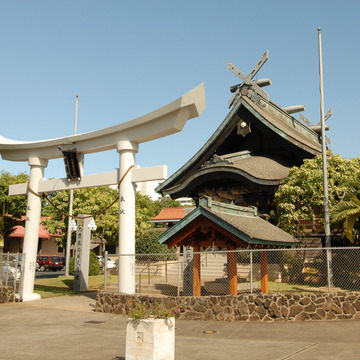Replicating the early Shinto shrine of Izumo Taisha in Shimane Prefecture, Japan, this finely detailed shrine was constructed by Takada, a master builder brought from Japan expressly for this project. Takada used wooden pegs instead of nails in all the joinery. When the building was moved to this site from Leleo Lane in 1966, it was modified to conform to modern building codes, following plans by Robert Katsuyoshi. However, it retains many traditional elements, including the dramatic roofline with chigi (crossed roof finials) and katsuogi (ridge ornaments), and its karahafu (double curved gable)–roofed kōhai (portico) with lion-head carved beam ends. The traditional elements of a Shinto shrine include a torii (gateway) accessing the spiritual realm, a wash area to the right for purification, and the entrance bell.
You are here
Izumo Taishakyo Mission
If SAH Archipedia has been useful to you, please consider supporting it.
SAH Archipedia tells the story of the United States through its buildings, landscapes, and cities. This freely available resource empowers the public with authoritative knowledge that deepens their understanding and appreciation of the built environment. But the Society of Architectural Historians, which created SAH Archipedia with University of Virginia Press, needs your support to maintain the high-caliber research, writing, photography, cartography, editing, design, and programming that make SAH Archipedia a trusted online resource available to all who value the history of place, heritage tourism, and learning.


